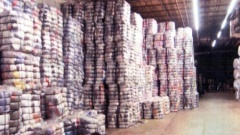Difference between revisions of "Rags"
From Cargo Handbook - the world's largest cargo transport guidelines website
(→Description) |
|||
| Line 1: | Line 1: | ||
{{Infobox_Miscellaneous | {{Infobox_Miscellaneous | ||
| − | | image = | + | | image = Rags-1.jpg |
| origin = - | | origin = - | ||
| − | | stowage factor = - | + | | stowage factor = <ul><li>2,32-2,43 m<sup>3</sup>/t (pressed bales)</li><li>3,96 m<sup>3</sup>/t (unpressed bales) |
| humidity and moisture = - | | humidity and moisture = - | ||
| ventilation = - | | ventilation = - | ||
| − | | risk factors = | + | | risk factors = See text |
}} | }} | ||
==Description== | ==Description== | ||
| − | + | ||
| − | + | ||
| − | + | ||
| − | + | ||
| − | |||
| − | |||
| − | |||
[[Category:Products]] | [[Category:Products]] | ||
Revision as of 12:36, 25 February 2014
| Infobox on Rags | |
|---|---|
| Example of Rags |  |
| Facts | |
| Origin | - |
| Stowage factor (in m3/t) |
|
| Humidity / moisture | - |
| Ventilation | - |
| Risk factors | See text |











